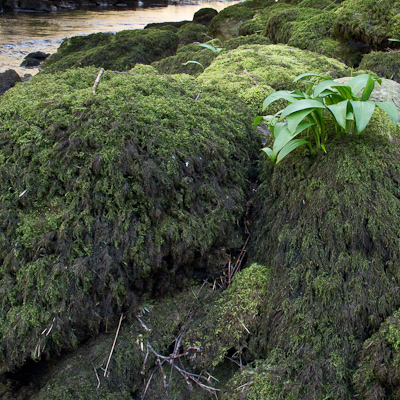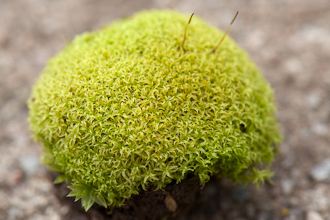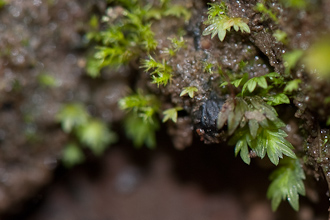
-
Shoot growth form / colour
-
Arrangement of the leaves
-
Details of the leaves
- Hairpoint:
-
Leaves recurved, hooked, squarrose
Note:
Apices bent abruptly to the side or downwards - Costa:
- Teeth:
- Leaf margins:
- Leaf surface:
-
Reproductive structures
- Distinctive gemmae present:
- Colour of seta:
- Form of the capsule:
Note:
Distinctive capsules only.
In the moss character menu, character states are grouped into one of six categories, each of these categories being described on its own page.
The page currently being viewed is indicated by both the white heading text above the character menu, as well as the lighter background on the character menu.
Following a link on the character menu leads to the corresponding content on the right panel which becomes highlighted with a lighter background and changing the page as required. It's also possible to navigate the pages sequentially by clicking on the links at the bottom of each page.
Each character state is described on the right panel, with a list of species showing that character, a photo of one of those species, and a couple of paragraphs describing the character state and its possible adaptive significance. A small left-pointing icon causes the corresponding character state link in the character menu to become highlighted, the page scrolling to that position.
Clicking on a photo opens the lightbox view showing a larger image. Navigation icons are provided below the image as follows:
- Clicking on the red/blue Flickr icon opens the corresponding image on the Green Light Images Flickr photostream.
- A green orientation icon provides a cue as to where you are as you loop through the images on the current page.
- The backward and forward icons step through the images on the current moss character page.
- The cross icon closes the lightbox view and returns you to the page where you originally entered the lightbox.

Every boulder on the banks of the River Almond below the bridge at Buchanty, is covered with loose carpets of the moss Thamnobryum alopecurum, making the scene look almost like shoreline rocks covered with Fucus seaweeds.
The objective of these character list and table pages is to aid bryophyte identification through familiarisation with conspicuous features shown by different species. In addition, the lists should also help eliminate potential candidates, by highlighting situations where a specimen possesses characters inconsistent with the species being considered, while the tables may reveal some correlations between shared characters and taxonomic affinity, as well as with substrate and habitat.
- Amphidium mougeotii
- Andreaea rupestris
- Barbula sardoa
- Bryum alpinum
- Bryum capillare*
- Campylopus atrovirens
- Ceratodon purpureus
- Fissidens dubius
- Grimmia laevigata
- Leucobryum spp.
- Orthotrichum stramineum
- Pohlia wahlenbergia*
- Pseudocrossidium revolutum
- Racomitrium heterostichum
- Schistidium maritimum
- Tortula muralis*
- Trichostomum brachydontium
- Ulota bruchii
- Ulota phyllantha
It seems likely that this growth habit is an adaptation to reduce water loss in such xeric niches, the cushion sheltering the lower parts of the shoots from drying winds and the ball-like form minimising the surface area to volume ratio of the shoot aggregate.
- Palustriella commutata
- Plagiothecium undulatum*
- Racomitrium fasciculare*
- Racomitrium lanuginosum*
- Schistidium rivulare*
- Syntrichia ruralis ssp. ruraliformis*
- Thuidium tamariscinum*
No doubt such rocky environments may become dry at times. It would appear that mosses forming loose mounds achieve a compromise between retaining moisture for dry spells, while still presenting a large photosynthetic area to the light.
- Amblystegium serpens
- Aulacomnium androgynum
- Aulacomnium palustre
- Barbula unguiculata
- Bartramia pomiformis
- Brachythecium albicans*
- Brachythecium populeum
- Brachythecium rutabulum
- Bryum alpinum
- Bryum capillare*
- Bryum pallens
- Bryum pseudotriquetrum
- Calliergon giganteum
- Calliergonella cuspidata
- Climacium dendroides
- Cratoneuron filicinum
- Ctenidium molluscum
- Dichodontium palustre
- Dicranoweisia cirrata
- Eurhynchium striatum
- Hedwigia stellata
- Hookeria lucens
- Hylocomium splendens
- Hypnum cupressiforme
- Hypnum jutlandicum
- Kindbergia praelonga
- Leucodon sciuroides
- Mnium hornum*
- Orthotrichum cupulatum
- Orthotrichum diaphanum
- Orthotrichum rivulare
- Plagiothecium undulatum*
- Pleurozium schreberi
 Pterygonium gracile (Leucodontaceae)
Pterygonium gracile (Leucodontaceae)- Pohlia wahlenbergia*
- Pseudoscleropodium purum*
- Pterygonium gracile
- Racomitrium fasciculare*
- Racomitrium lanuginosum*
- Rhynchostegium confertum
- Rhytidiadelphus loreus
- Rhytidiadelphus triquetris
- Rhizomnium punctatum*
- Schistidium rivulare*
- Syntrichia laevipila
- Syntrichia ruralis ssp. ruraliformis*
- Tetraplodon mnioides
- Thamnobryum alopecurum*
- Thuidium tamariscinum*
- Tortella tortuosa*
- Warnstorfia fluitans
Tufts perhaps represent groupings of moss shoots that are at times under water stress, while the mossy carpets benefit from the shelter in woodlands, as well as that provided by less intesively-managed grass lawns.
The photograph of Pterygonium gracile shows just one part of a more extensive patch of this moss, growing at the base of an Ash tree in woodland on Knockdolian Hill in Ayrshire. The herbaceous ground flora was not very well developed on the steep slopes, and so bryophytes had little competition for light and soil moisture.
- Atrichum undulatum
- Brachythecium albicans*
- Bryum argenteum
- Fissidens bryoides
- Funaria hygrometrica
- Gyroweisia tenuis
- Mnium hornum*
- Philonotis fontana
- Plagiomnium ellipticum
- Pogonatum aloides
- Polytrichum piliferum
- Pseudoscleropodium purum*
- Rhizomnium punctatum*
- Thamnobryum alopecurum*
- Tortella tortuosa*
- Tortula muralis*
As for adaptive significance, perhaps in this case there isn't obvious evidence for growth habit evolution; instead, the hostile environment of stone may only support a few individual moss plants, while the ephemeral nature of muddy banks requires that each moss plant completes its life cycle before further erosion washes the niche bare.
- Gymnostomum aeruginosum
- Gyroweisia tenuis
- Weissia controversa
Such minute species appear to favour damp stone as a substrate, often forming a large green expanse over the surface. Being so small, these moss communities presumably enjoy the relatively moist air of the laminar layer of unturbulent air.








